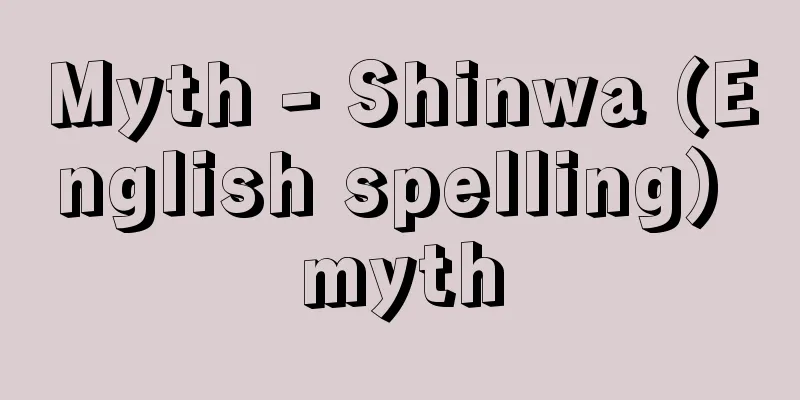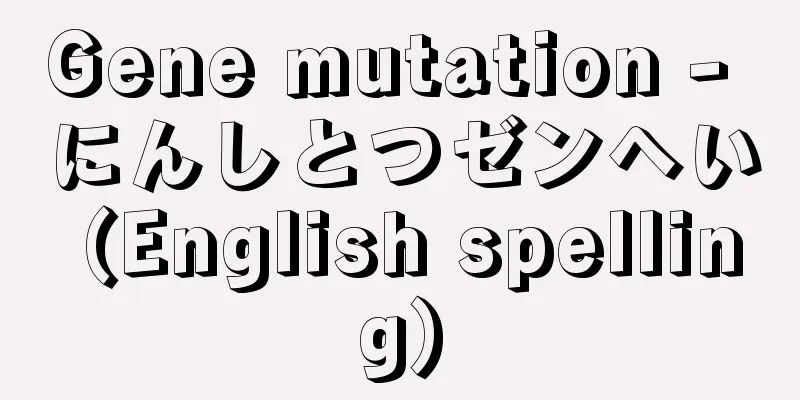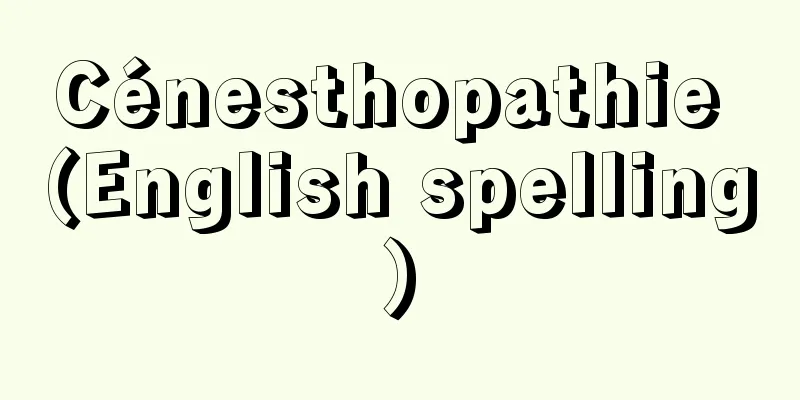Myth - Shinwa (English spelling) myth

|
It is difficult to give a clear definition of myth. Not only is the term used in a variety of ways, such as to describe a tale, a legend, or a story that is unlikely to have happened in reality, but there is also no consistency in its usage among mythology researchers. Even a great authority such as the British classical scholar GS Kirk (1921- ) has stated that a strict definition is impossible, and that forcing a definition would make mythology more difficult to understand. However, there is no doubt that what is collectively called myth, even if it is somewhat vague, has an important meaning and has played a role in human culture. The biggest reason why it has become difficult to give an academic definition of myth is the recognition that there are subtle differences in this phenomenon depending on the culture. Humans have passed down stories that originated in ancient times as sacred tales, but at first glance, the contents of these stories are all absurd, filled with mysteries and strange events that could never happen in reality, and incest and other immoral acts. However, this is not because people were unable to think rationally or because they did not know morality. It is simply because people were born in a chaotic world before the current world order and rules for how humans should live were born. The distinction between humans and animals is often ignored, with animals behaving as if they were humans, and ancestors who are neither human nor animal playing the role of the main character, for the same reason. In ancient times, when the events described in myths occurred, there was no distinction between humans, animals, and spirits, or if there was, it was vague. For people whose cultures hold these stories sacred and pass them down, myths are believed to be true stories that satisfy themselves about human destiny and order, and they permeate every detail of life as norms. In other words, humans have created and passed down unique sacred stories in each culture and lived their lives in accordance with them, and myths have always been reflected in their lives. However, this inseparable relationship between human activities and myths was not recognized to the same degree by all people. Usually, myths are kept secret from women and children, and are taught only to adult men as secret teachings that must not be disclosed without permission. Moreover, in many cases, there are stages in the teaching of secret teachings, so the number of people who go through all the stages and become masters of the mysteries is limited. In other words, the majority of people unconsciously live myths and live their lives reflecting ethics and order by simply behaving as a habit. [Atsuhiko Yoshida] Mythological SimilaritiesEach culture creates and passes on its own unique mythology, but the stories, elements, and forms of these stories are easily transferred to other cultures and are often adopted as material for other systems. In addition, myths themselves are often brought to other regions with the movement of peoples and the spread of cultures. In such cases, the myths that are brought in mix with myths that existed there before, or are transformed by incorporating content from them in various places, and are reborn as new myths. This kind of spread of myths must have already begun in the Late Paleolithic period, more than 10,000 years ago, when the Old and New continents were still connected. Therefore, if we trace the path of mythological spread as far as possible, we can go so far as to say that myths all over the world are distantly related to each other. In fact, when comparing myths from regions far apart, we always find considerable similarities. For example, French anthropologist Lévi-Strauss speculates that the distinctive similarities found between Japanese mythology and the mythology of the indigenous peoples of North and South America may be due to the fact that both regions adopted the basic mythological foundations from continental Asia during the Paleolithic period. Another fundamental reason for the similarity of myths is that the mechanisms of the human psyche that generate myths are the same for all humankind. This can be confirmed by the fact that the contents of myths often coincide surprisingly well with the images and events that appear in the dreams of people who are completely unaware of the myth. The Swiss depth psychologist Jung tried to explain this by inheriting Freud's theory of the unconscious. According to Jung, the universal unconscious is the innate foundation of the human psyche, and various images are generated in the mind by working according to certain patterns that Jung called archetypes. These images are diverse, reflecting differences in individual experiences, environments, and cultures to which one belongs, but there is still a commonality that transcends this diversity when they are generated by the same archetype. According to Jung's theory, myths, like dreams, are valuable clues to understanding the structure and function of the most elusive foundations of the human mind, so Jungian psychologists study myths from this standpoint and try to use the results of their research in psychotherapy. [Atsuhiko Yoshida] The function of mythHumans, who do not simply adapt to the natural environment they are given, but instead try to adapt the environment to themselves, cannot survive without providing a systematic explanation for the relationship between the environment and themselves and giving meaning to their actions in light of that explanation. Humans have the ability to grasp the law of causality and think rationally, which has led to the development of tools, technology, science, and so on. However, for things that cannot be explained rationally, such as the world and the meaning of human life and death, they have provided systematic explanations through myths and built cultures accordingly. In mythology, irrational explanations are given for things that can be explained scientifically today, such as why solar and lunar eclipses occur, why the sun that sets in the west at dusk rises again in the east the next morning, or why the sun and moon always appear separately in the daytime and nighttime sky. However, these things that can be explained scientifically are merely minor details, not the core of the issues that mythology deals with. The core of mythology is related to the very foundation of human existence, so explaining it will forever be beyond the realm of rational thinking and its product, science. Moreover, all myths are ambiguous. For example, in ancient Egyptian mythology, the reason why the sun sets in the west at dusk and rises in the east the next morning is explained as the sun passing through the underworld during the night to illuminate the land of the dead. This myth not only explains the phenomenon of sunset and sunrise, but also the structure of the universe, and teaches the reality that death is inevitable for life to continue. Furthermore, Jungian psychologists argue that the Greek myth of the sun sailing from the far west to the far east in a golden cup during the night is a typical expression of the "anguish" necessary for personality formation, which Jung called a "nocturnal voyage on the sea." Meanwhile, Japanese mythology tells us that the reason why the sun and moon appear at different times during the day and night is that one day, the god of food spat out various delicacies from his mouth on earth to feed to the moon god, but the moon god became angry and killed the god, enraging her sister, the sun goddess Amaterasu Omikami. This myth also explains the origins of agriculture and culture, telling us that grains, silkworm cocoons, and cattle and horses sprouted from the corpse of the slain food god, and that Amaterasu had them cultivate fields in Takamagahara and started sericulture. Amaterasu's anger at the moon god's violence preaches the need for order, but at the same time, it also represents the goddess's assertion, as a pure virgin and mother, that bloodshed should be detested, and her boundless compassion for mankind, which led her to willingly start farming for them. At the same time, it also explains why night and death, the opposite of day and life, are absolutely necessary and inevitable for the world and humanity, despite the goddess's aversion to them. In human culture, myth and rational thought have a complementary relationship, rather than the former becoming unnecessary due to the development of the latter. This relationship has not fundamentally changed even in modern culture, where science and technology, the products of rational thought, have become so highly developed that myth in the form of traditional stories seems to have lost its vitality. [Atsuhiko Yoshida] Myth and modern timesThere is no room for doubt about the scientific explanation of solar and lunar eclipses, sunsets and sunrises. However, science can never fully explain the mystical meanings of these phenomena that go beyond the rational explanation. This is the same as the fact that a scientific explanation of death is almost useless in easing emotional grief. In other words, science can only explain one aspect of a thing that can be rationally dealt with. No matter how much science develops, it can never make use of or replace the function that myths have played in human culture. Therefore, even modern people who consciously think that they do not believe in myths actually need myths and cannot live without things that fulfill the functions of myths. In response to this need, modern culture is constantly producing various myths and imitations. Even people who think that science is absolute are actually living their lives with even the smallest details of their daily actions regulated by their belief in the myths and pseudo-myths created by their own culture. These myths and pseudo-myths that have emerged from modern culture do not take the form of stories about ancient events. For this reason, it is problematic to include them in the category of myths. However, in terms of the meaning and function they have for humans and culture, they are clearly myths. They share a commonality with ancient myths in that the majority of people who believe in them and live according to them are not clearly aware of this. Moreover, the images and ideas common to myths around the world that Jung tried to explain with his theory of the universal unconscious can be clearly found in these modern myths. From this point of view, it is important to recognize them as a type of myth and compare them with other myths. In this way, while humans have always thought and acted rationally, they have inevitably relied on myths to deal with things that they cannot understand rationally. Each human culture has created its own unique myths and has used them in their lives, so no culture can be understood without looking at the myths that underpin it. Conversely, by looking at things in the light of myths, we can see that acts that appear to us as nothing more than barbaric acts, such as headhunting and cannibalism, had meaning and value as cultural acts in the cultures in which they were practiced. The explanations that myths have given to the meaning of the world and human existence, which are fundamentally impossible to explain rationally, are indeed irrational. However, at the same time, it is meaningless to compare them to one another and discuss their superiority or inferiority; each has its own inherent absolute value. And since this absolute value is what gave birth to the myth itself and is also the value of a living culture, we are reminded that there is no superiority or inferiority among the various cultures that humans have cultivated since ancient times, and that while all are irrational and barbaric, they also have their own inherent "absolute value." [Atsuhiko Yoshida] "Myths: Dreams and Truths of Mankind" by Alexander Eliot et al., translated by Obayashi Taryo (1981, Kodansha)" ▽ "The Structure of Myth" by Yoshida Atsuhiko (1978, Asahi Publishing)" ▽ "Myths: Meaning and Function" by G.S. Kirk, translated by Uchibori Motomitsu (1976, Shakaishisosha)" ▽ "Myths and Mythology" by Obayashi Taryo (1975, Yamato Shobo)" [References] | [Supplementary Material] |Source: Shogakukan Encyclopedia Nipponica About Encyclopedia Nipponica Information | Legend |
|
神話を明確に定義づけることはむずかしい。というのは、この語は説話や伝説、あるいは現実には起こりそうにもない話など、あまりに多様な用いられ方をするだけでなく、神話の研究者の間でも用法が一定していないからである。イギリスの古典学者カークG. S. Kirk(1921― )のような大家すら、厳密な定義をすること自体が不可能であり、また無理に定義づけをするとかえって神話を理解しにくくする、と明言している。しかし神話と総称されるものが、多少あいまいではあっても、人間の文化のなかで重要な意味をもち、またその役割を果たしてきたことには疑問の余地がない。神話に学問的定義を与えるのが困難になった最大の理由は、それぞれの文化によってこの事象に微妙な違いがあることが認識された結果にほかならない。 人間は、太古に生まれた物語を、神聖な説話として伝承してきたが、その内容は一見するといずれも荒唐無稽(こうとうむけい)で、現実には起こりえないような不思議や珍事、近親相姦(そうかん)などの不倫が続発する。しかしこれは合理的な思考ができなかったからでも、道徳を知らなかったからでもない。ただ、現在の世界の秩序や人間の生き方のルールが生まれる以前の、混沌(こんとん)とした世界で生まれたからにすぎない。人間と動物の区別もしばしば無視され、動物がまるで人間のようにふるまったり、動物とも人間ともつかない祖先たちが主人公の役を演じたりするが、これも同じ理由による。神話の物語る事件が起こった太古には、人間と動物、そして精霊などの区別がまだなかったか、あってもあいまいだったのである。 これらの説話を神聖視して伝承する文化をもつ人々にとっては、神話は人間の運命や秩序について自ら納得する真実の話として信じられ、規範として生活の細部にまで浸透していた。いいかえれば、人間はそれぞれの文化のなかで固有の神聖な説話を生み出し、かつ伝承しながらそれに則して生活を営んできたわけで、そこにはつねに神話が反映されていたといってよい。しかし、人間の営為と神話とのこのような不可分的関係は、すべての人々に同程度に意識されていたわけではない。普通、神話は女性や子供たちには秘密にされ、成人の男性だけに、みだりに口外してはならない秘伝として教えられる。しかも多くの場合、秘伝の教授には段階が設けられているので、すべてを通過して奥義にまで通暁する者の数は限られる。つまり大多数の人々は、単に習慣としてふるまうことで、無意識のうちに神話を生き、倫理や秩序を反映させながら生活しているのである。 [吉田敦彦] 神話の類似性それぞれの文化は固有の神話を生み出し、伝承するが、その説話や話素、話形などはほかの文化へ容易に伝わり、別の体系の素材として取り入れられることが多い。また民族の移動や文化の伝播(でんぱ)に伴って、神話そのものが別の地域に持ち込まれることもしばしばある。その場合、持ち込まれた神話は以前からそこにあった神話と混じり合い、あるいは随所にその内容を取り入れるなどして変貌(へんぼう)し、新しい神話として再生される。このような神話の伝播は、新旧両大陸がまだ地続きであった1万年以上前の、後期旧石器時代にすでに始まっていたに違いない。したがって、神話の伝播の跡をどこまでもたどっていけば、世界中の神話は互いに遠い親戚(しんせき)関係にあると極言することもできよう。事実、どれほど遠く隔たった地域の神話でも、比較すると、かならずかなりの類似点がみつかる。たとえば、フランスの人類学者レビ・ストロースは、日本の神話と南北両アメリカ大陸の原住民の神話の間に特異な類似点がいくつかみいだされるのは、両地域が旧石器時代にアジア大陸から共通の神話の基本を受け入れたためであろうと推定している。 神話が類似するもう一つの根本的原因は、神話を発生させる人間の精神の機構に、全人類共通の同一性があることであろう。これは、神話の内容がしばしば、その神話をまったく知らない人がみる夢のなかに現れるイメージやできごとと、驚くほどよく一致するという事実からも確かめることができる。このことをスイスの深層心理学者ユングは、フロイトの無意識の理論を継承しながら説明しようとした。ユングによれば、普遍的無意識は先天的な人間の心の基層であり、ユングが原型とよぶいくつかの一定の型に従った働きによって、さまざまなイメージを心のうちに発生させる。これらのイメージは、個人の経験や環境、属する文化の違いなどを反映して多種多様であるが、それでも同じ原型によって生み出されるものにはその多様性を超えた共通性があるとする。このユングの理論によれば、神話は夢と同じように、人間の心のとらえがたい最基層部の構造とその働きを知るのに貴重な手掛りとなるので、ユング派の心理学者たちはこの立場から神話を研究し、その成果を心理療法にも役だてようとしている。 [吉田敦彦] 神話の機能与えられた自然環境にそのまま適応せず、環境を自己に適応させようとする人間は、環境と自己に対する関係に体系的説明を与え、それに照らして自分の行為を意味づけずには生きていくことができない。人間には因果律をとらえて合理的思考をする能力があり、それによって道具や技術、科学などが発達した。しかし、合理的にはけっして説明のつかない世界や人間の生死の意味などには、神話によって体系的な説明を与え、それに則して文化を構築してきた。 神話のなかでは日食や月食のおこる理由とか、日暮れに西の果てに没した太陽が、なぜ翌朝にはまた東の果てから昇ってくるのかとか、あるいは太陽と月は、なぜいつも昼と夜の空に別れて現れるのかなどといったような、現代では科学的に説明できるようなことにも、非合理的な説明が与えられている。だがこういった科学的な説明が可能な事柄は、神話の取り扱う問題の核心ではなく、枝葉末節にすぎない。神話の核心は、人間の存在のまさに根本にかかわるので、それに説明を与えることは永遠に合理的思考とその産物である科学の埒外(らちがい)にある。そのうえ、神話はどれも多義的である。たとえば、日暮れに西に沈んだ太陽が翌朝東から昇る理由は、古代エジプトの神話では、夜の間太陽が地下界を通り抜けながら死者の国を照らすためと説明されている。この神話は、日没と日の出の現象と同時に宇宙の構造にも説明を与え、生が持続するためには死が不可避である現実をも教えている。さらにユング派の心理学者たちは、太陽が夜の間に黄金の杯に乗って西の果てから東の果てまで航海するというギリシア神話などに、ユングが「夜の海の航海」とよんだ、人格形成のために必要な「懊悩(おうのう)」が典型的に表現されているとしている。 一方、太陽と月が昼夜別々に出る理由を、日本の神話では、あるとき食物の神が、地上で口からさまざまな御馳走(ごちそう)を吐き出して月神に食べさせようとしたのを、月神が怒ってこの神を殺してしまい、姉の太陽女神天照大神(あまてらすおおみかみ)を激怒させたためと物語られている。この神話は同時に殺された食物神の死体から五穀と蚕の繭(まゆ)、それに牛馬が発生し、それを天照大神が高天原(たかまがはら)で田畑をつくらせて養蚕を始めたと物語ることにより、農業と文化の起源をも説明している。月神の乱暴に対する天照大神の怒りは、秩序の必要を説くと同時に、純潔の処女であり母でもある女神の、流血は嫌悪するべきであるとの主張、さらに喜んで人間のために農耕を始めたという限りない人類への慈しみを表している。そして同時に昼と生の裏腹をなす夜と死が、女神の忌避にもかかわらず、世界と人類にどうしても必要であり、不可避であるわけも説明している。 人間の文化にとって神話と合理的思考とは、後者の発達によって前者が不要になるのではなく、互いに補完的な関係にある。この関係は、合理的思考の産物である科学と技術が極度に発達し、伝統的説話の形での神話が生命を失ってしまったようにみえる現代の文化においても、根本的にはなんら変わってはいない。 [吉田敦彦] 神話と現代日食や月食、日没や日の出などの科学的説明には、まったく疑問の余地はない。しかし、これらの事象の合理的説明を超えた神秘的意味まで説明し尽くすことは、科学にはけっしてできない。これは、死について科学的説明をしても、感情的には悲しみを和らげるために、ほとんどなんの役にもたたないのと同様である。つまり科学による説明が可能なのは、ただその事物の合理的に処理できる一面だけにすぎない。科学は、たとえどのように発達しても、人間の文化のなかで神話が果たし続けてきた機能を無用にしたり、それにとってかわることは、けっしてできないのである。したがって、意識的には神話を信じていないつもりの現代人も、現実には神話を必要としており、神話の機能を果たすものを欠いては生きていくことができない。この必要にこたえて、現代の文化も絶えずさまざまな神話や擬似物を生み出している。科学を絶対視しているつもりの人々も、現実にはやはり自己の文化が生み出す神話、あるいは擬似神話を信じることにより、日々の行動の細部まで律せられて生きているのである。 現代文化から生まれるこれらの神話、あるいは擬似神話は、太古に起こったできごとに関する物語の形をとってはいない。そのため、これらを神話の範疇(はんちゅう)に含めることには問題があるが、それでも人間と文化にとってもつ意味とその果たす機能という点では、明らかに神話といってよい。それを信じ、それに従って生きている人々の大部分がそのことをはっきりとは意識していないという点でも、太古の神話のありようと共通性がみられる。しかも、ユングが普遍的無意識論で説明しようとした、世界中の神話に共通するイメージと発想は、これら現代の神話にもはっきりとわかる形でみいだすことができる。この点からも、やはりこれらを神話の一種と認めて、ほかの神話と比較してみることがたいせつであろう。 このように人間はつねに合理的に物事を考え行動する一方、合理的に理解することができないものの処理は必然的に神話に頼り生きてきた。人間の文化はそれぞれ固有の神話を生み出し、またそれを生活のなかに生かしてきたので、どんな文化でもその根拠となっている神話に照らさずには理解することはできない。逆に神話に照らしてみることによって、たとえば首狩りや食人のような、われわれにはまったく蛮行としかみえぬ行為にも、それを習俗とする文化のなかでは、やはり文化的行為としての意味と価値があったことが知られる。 もともと合理的説明が不可能な世界と人間の実存の意味に神話が与えてきた説明は、やはり不合理ではある。しかし、同時にほかと比較して優劣を論じることも無意味で、それぞれが固有の絶対的価値をもつ。そしてその絶対的価値はその神話そのものを生み出し、また生きた文化の価値でもあるので、人間が古来営んできたさまざまな文化の間に価値の優劣はなく、すべてが非合理で野蛮であると同時に固有の「絶対的価値」をもつことを思い知らされるのである。 [吉田敦彦] 『アレグザンダー・エリオット他著、大林太良訳『神話――人類の夢と真実』(1981・講談社)』▽『吉田敦彦著『神話の構造』(1978・朝日出版社)』▽『G・S・カーク著、内堀基光訳『神話――その意味と機能』(1976・社会思想社)』▽『大林太良著『神話と神話学』(1975・大和書房)』 [参照項目] | [補完資料] |出典 小学館 日本大百科全書(ニッポニカ)日本大百科全書(ニッポニカ)について 情報 | 凡例 |
Recommend
Aichu - Aichu
...The third floor was entirely used for the room...
Boris Ivanovich Ravenskikh
1914‐80 Soviet director. A student of Meyerhold. P...
Uklad - Uklad (English spelling) уклад/uklad Russian
A Russian term referring to different types of pr...
Allan Kaprow
American contemporary artist. Known as the founde...
Small group activities
It is one of the methods of participation in manag...
Administrative Procedure Act
This law was enacted to ensure fairness in adminis...
Chevreul
1786‐1889 French chemist. Born in Angers, he joine...
Islam - Islam (English spelling)
A religion founded in the early 7th century by Muh...
Clinoptilolite
...Many known sources of zeolite are known, inclu...
Alcock, JW
...He died when landing at his destination), foll...
Eastern Zone - Toshu
770 to 256 The name of the Zhou dynasty after the ...
Atomized powder - Atomized powder
When molten metal or alloy is made to flow out of ...
Nine schools and a hundred schools
…In China, there are nine schools of thought. The...
Ulrich von Wilamowitz‐Moellendorff
1848‐1931 A German classical scholar, he studied a...
Auditory hallucinations
〘 noun 〙 A sensory disorder in which sounds and vo...









